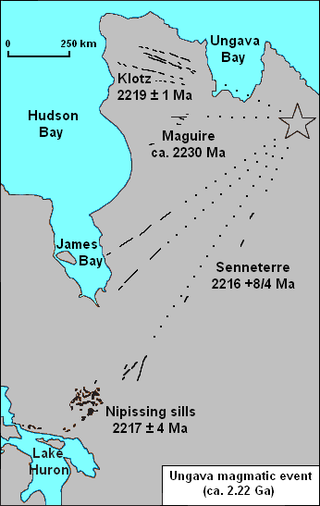Top Qs
Timeline
Chat
Perspective
Nipissing sills
From Wikipedia, the free encyclopedia
Remove ads

The Nipissing sills, also called the Nipissing diabase, is a large 2217– to 2210–million year old group of sills in the Superior craton of the Canadian Shield in Ontario, Canada,[2] which intrude the Huronian Supergroup.[3] Nipissing sills intrude all the Huronian sediments and older basement rocks in the northern margin of the Sudbury Basin;[4]: 25, 67 they were emplaced after the faulting and folding of Huronian rocks, and are hornblende gabbro of tholeiitic basalt composition.[4]: 25 In the Sudbury–Elliot Lake area the Nipissing diabase is deformed; outcrops are parallel to the fold axes of the Huronian sedimentary rocks.[3] Nipissing diabase intrusions are east-northeast trending and are no wider than 460 m (1,510 ft).[5]: 972
The Nipissing sills in the Southern Province of the Superior craton are thought to originate from a radiating dike swarm area 1,300 km (810 mi) to the northeast.[6]: 3 The mantle source for the Nipissing sills did not come from the mantle beneath the Southern Province that had generated the 2500– to 2450–million year old Matachewan dike swarm.[6]: 3 The 2217– to 2210–million year old Ungava magmatic event – located under the Labrador Trough – fed the Nipissing sills;[6]: 3, 5 evidence shows the sills were laterally fed from a mantle plume center 1,500 km (930 mi) away via the 2216–million year old Senneterre dikes which form part of the radiating dike swarm.[7]
In 1911, Willett G. Miller named the Nipissing diabase type area at Cobalt, Ontario.[1][8]
Remove ads
See also
References
Wikiwand - on
Seamless Wikipedia browsing. On steroids.
Remove ads
